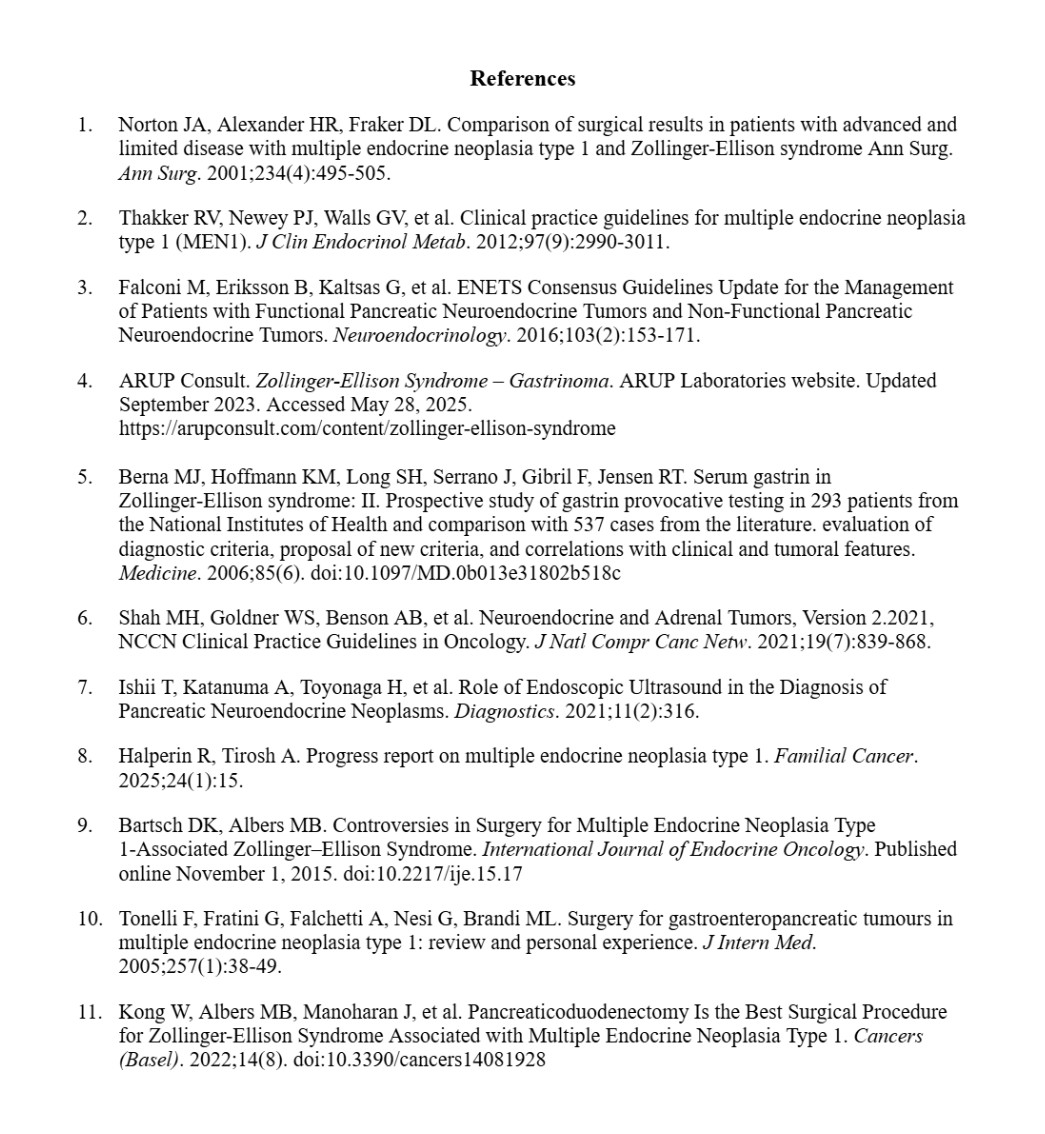Sunday Poster Session
Category: Small Intestine
P1965 - Persistent Zollinger-Ellison Syndrome in a MEN1 Patient with Negative Imaging
Sunday, October 26, 2025
3:30 PM - 7:00 PM PDT
Location: Exhibit Hall

Kathryn Tovar, DO, MPH, MS
Santa Barbara Cottage Hospital
Santa Barbara, CA
Presenting Author(s)
Kathryn Tovar, DO, MPH, MS, Rebecca Salvo, DO, Lindsay Katona, DO, MPH, Eren Veziroglu, MD, MS, Kishan Ghadiya, MD
Santa Barbara Cottage Hospital, Santa Barbara, CA
Introduction: Zollinger-Ellison syndrome (ZES) produces acid hypersecretion and refractory peptic ulcer disease via gastrin-secreting tumors. Roughly 30% arise in Multiple Endocrine Neoplasia type 1 (MEN1), where gastrinomas are usually multiple, duodenal, and < 0.5 cm. Biochemical diagnosis requires fasting hypergastrinemia with gastric pH ≤ 2 or a secretin-stimulated rise ≥ 120 pg/mL when gastrin is < 1000 pg/mL. After confirmation, contrast-enhanced CT/MRI, Ga-68 DOTATATE PET/CT, and high-resolution endoscopic ultrasound (EUS) localize disease; correction of hyperparathyroidism tempers acid output.
Case Description/
Methods: A 66-year-old man with sporadic MEN1 underwent distal pancreatectomy for a 2.5 cm well-differentiated pancreatic neuroendocrine tumor. Six months later he re-presented with hematemesis, melena, and hypotension (hemoglobin 6.9 g/dL). CT angiography and selective angiography showed gastric and proximal duodenal wall thickening and a small gastroduodenal-artery pseudoaneurysm that was embolized but no active extravasation. Esophagogastroduodenoscopy revealed a 3 cm duodenal-bulb ulcer with adherent clot refractory to high-dose proton-pump inhibitors (PPIs). Fasting gastrin measured 448 pg/mL on PPI and 594 pg/mL off therapy, confirming persistent ZES despite previous surgery. Repeat CT, MRI, Ga-68 DOTATATE PET/CT, and EUS failed to localize a residual gastrinoma.
Discussion: MEN1-ZES is difficult to cure surgically because tumors are often tiny and multifocal, and biochemical persistence is common even with negative imaging, as illustrated here. Current guidelines reserve surgery for lesions ≥ 2 cm, rapid growth, uncontrolled hyperacidity, or nodal/hepatic spread, typically using pancreas-preserving duodenectomy or pancreaticoduodenectomy (PD) with lymphadenectomy. PD yields an 82% biochemical cure versus 21% after limited resection at 12-year median follow-up. Long-acting somatostatin analogues and peptide-receptor radionuclide therapy offer disease control when surgery is contraindicated or metastatic disease progresses. This case underscores the need for continued clinical suspicion, repeated high-resolution imaging, and timely consideration of definitive surgery in MEN1 patients with persistent ZES despite negative studies. Portions of this abstract were drafted with assistance from generative AI; all text was reviewed, revised, and approved by the authors, who assume full responsibility for the final content.

Figure: References
Disclosures:
Kathryn Tovar indicated no relevant financial relationships.
Rebecca Salvo indicated no relevant financial relationships.
Lindsay Katona indicated no relevant financial relationships.
Eren Veziroglu indicated no relevant financial relationships.
Kishan Ghadiya indicated no relevant financial relationships.
Kathryn Tovar, DO, MPH, MS, Rebecca Salvo, DO, Lindsay Katona, DO, MPH, Eren Veziroglu, MD, MS, Kishan Ghadiya, MD. P1965 - Persistent Zollinger-Ellison Syndrome in a MEN1 Patient with Negative Imaging, ACG 2025 Annual Scientific Meeting Abstracts. Phoenix, AZ: American College of Gastroenterology.
Santa Barbara Cottage Hospital, Santa Barbara, CA
Introduction: Zollinger-Ellison syndrome (ZES) produces acid hypersecretion and refractory peptic ulcer disease via gastrin-secreting tumors. Roughly 30% arise in Multiple Endocrine Neoplasia type 1 (MEN1), where gastrinomas are usually multiple, duodenal, and < 0.5 cm. Biochemical diagnosis requires fasting hypergastrinemia with gastric pH ≤ 2 or a secretin-stimulated rise ≥ 120 pg/mL when gastrin is < 1000 pg/mL. After confirmation, contrast-enhanced CT/MRI, Ga-68 DOTATATE PET/CT, and high-resolution endoscopic ultrasound (EUS) localize disease; correction of hyperparathyroidism tempers acid output.
Case Description/
Methods: A 66-year-old man with sporadic MEN1 underwent distal pancreatectomy for a 2.5 cm well-differentiated pancreatic neuroendocrine tumor. Six months later he re-presented with hematemesis, melena, and hypotension (hemoglobin 6.9 g/dL). CT angiography and selective angiography showed gastric and proximal duodenal wall thickening and a small gastroduodenal-artery pseudoaneurysm that was embolized but no active extravasation. Esophagogastroduodenoscopy revealed a 3 cm duodenal-bulb ulcer with adherent clot refractory to high-dose proton-pump inhibitors (PPIs). Fasting gastrin measured 448 pg/mL on PPI and 594 pg/mL off therapy, confirming persistent ZES despite previous surgery. Repeat CT, MRI, Ga-68 DOTATATE PET/CT, and EUS failed to localize a residual gastrinoma.
Discussion: MEN1-ZES is difficult to cure surgically because tumors are often tiny and multifocal, and biochemical persistence is common even with negative imaging, as illustrated here. Current guidelines reserve surgery for lesions ≥ 2 cm, rapid growth, uncontrolled hyperacidity, or nodal/hepatic spread, typically using pancreas-preserving duodenectomy or pancreaticoduodenectomy (PD) with lymphadenectomy. PD yields an 82% biochemical cure versus 21% after limited resection at 12-year median follow-up. Long-acting somatostatin analogues and peptide-receptor radionuclide therapy offer disease control when surgery is contraindicated or metastatic disease progresses. This case underscores the need for continued clinical suspicion, repeated high-resolution imaging, and timely consideration of definitive surgery in MEN1 patients with persistent ZES despite negative studies. Portions of this abstract were drafted with assistance from generative AI; all text was reviewed, revised, and approved by the authors, who assume full responsibility for the final content.

Figure: References
Disclosures:
Kathryn Tovar indicated no relevant financial relationships.
Rebecca Salvo indicated no relevant financial relationships.
Lindsay Katona indicated no relevant financial relationships.
Eren Veziroglu indicated no relevant financial relationships.
Kishan Ghadiya indicated no relevant financial relationships.
Kathryn Tovar, DO, MPH, MS, Rebecca Salvo, DO, Lindsay Katona, DO, MPH, Eren Veziroglu, MD, MS, Kishan Ghadiya, MD. P1965 - Persistent Zollinger-Ellison Syndrome in a MEN1 Patient with Negative Imaging, ACG 2025 Annual Scientific Meeting Abstracts. Phoenix, AZ: American College of Gastroenterology.

